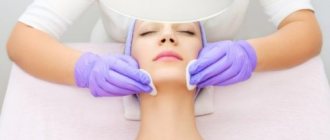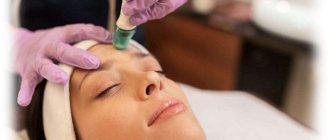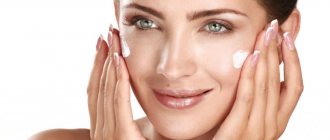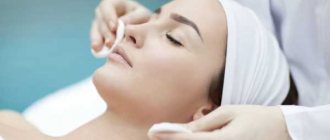Facial cleansing is the only way to cope with most defects, and the question of whether peeling can be done during pregnancy often worries women preparing to become mothers. Not all drugs used in skin cleansing procedures have an aggressive effect. Often women go to a beauty salon without fear, believing that soft, gentle ingredients will not harm the baby. It happens that they do not even warn the cosmetologist about pregnancy. This is a rather dangerous mistake that can lead to complications in the health or even development of the baby. Is it worth the risk, and what procedures for cleaning the dermis are considered the safest for the expectant mother and baby? To answer these troubling questions, you need to know the features of each type of peeling and contraindications to its implementation.
Peeling during pregnancy: is it possible or not?
Peeling is the mechanical removal of aged skin cells, which promotes its rejuvenation. With the help of various abrasive particles, acids and other substances, it is possible to significantly rejuvenate the skin, making it velvety, elastic, and fresh.
During pregnancy, all women who regularly exfoliate show a desire, just like outside pregnancy, to take care of their skin. However, not all types of peeling are allowed during this period, because many of them have a rather aggressive effect on the skin and can disrupt the course of pregnancy.
Cosmetologists recommend resorting to light peeling using soft peeling scrubs for home use or contacting professional beauty salons, which will carry out a procedure suitable for the skin of pregnant women.
Experts strongly do not recommend doing deep peels with acids. They are contraindicated during pregnancy. The danger of such a procedure is that acids significantly damage the epidermis, and the body has to spend energy on its restoration. And during pregnancy, this is considered a very inappropriate waste of nutrients and energy that should be spent on the development of the fetus.
In addition, hormonal levels are disrupted during pregnancy, and it is very difficult to predict how the skin will react to acids. An acute allergic reaction may develop, an infectious process may appear against the background of a decrease in local immunity, and pigmentation may increase.
Sometimes facial peeling during pregnancy becomes a necessary measure. In such cases, the cosmetologist selects a suitable cleansing method, for example, ultrasonic or traditional mechanical peeling. In this case, the stress on the skin will be insignificant.
Manicure and pedicure.
Obviously, nail care also does not involve any invasive procedures. On the other hand, when asked whether pregnant women can have a manicure, SM-Cosmetology specialists answer in the affirmative, but with one caveat. Volatile chemical compounds should not be used when treating nail plates. Of course, the volume of such vapors that can be inhaled in one session is negligible.
But when giving a woman a manicure during pregnancy, our masters prefer to completely eliminate even the slightest danger to the child. The result will be well-groomed and beautiful nails on your hands and feet.
Chemical peeling during pregnancy
Peeling using chemicals is always accompanied by an aggressive effect on the epidermis. Therefore, during pregnancy, you should immediately discuss your situation with a cosmetologist, who will recommend safe substances for the woman and her baby.
Only an experienced cosmetologist can determine which peelings are allowed during pregnancy. There are only a few acids that are not able to penetrate the bloodstream and affect the development of the fetus. These acids include:
- all types of alphahydroxy acids;
- lactic acid;
- glycolic acid.
All other types of acids are aggressive to the skin of a pregnant woman, so resorting to their help during gestation is very dangerous. If you ignore the recommendations of a cosmetologist and do one of the aggressive acid peels during pregnancy, for example, salicylic, the most unpredictable complications may arise, including termination of pregnancy.
Advice! It is better to ask a cosmetologist in advance about what types of peeling are allowed for pregnant women. Taking into account your gestational age and skin type, he will select the ideal option for cleansing your dermis.
Acne vulgaris is a chronic inflammatory disease of the pilosebaceous unit and is characterized by non-inflammatory (comedones) and inflammatory lesions (papules, pustules and nodules) that can lead to scar formation and psychological stress. In women who are planning a pregnancy or who are pregnant, this condition can be especially bothersome given the physiological changes as well as the unpredictable nature of acne during this time. Acne often improves during the first trimester, but can worsen during the third trimester due to increased androgen levels and increased sebum production. In addition to hormonal changes, immunological changes may also contribute during pregnancy. Inflammatory lesions tend to be more widespread than noninflammatory lesions, often extending to the trunk. Patients with a history of acne are more likely to develop acne during pregnancy. Treating acne during pregnancy can be challenging, as many commonly used and effective treatment options are contraindicated or not recommended. Therefore, it is important for the physician prescribing therapy for a pregnant woman to be familiar with the treatment restrictions adopted by the US Food and Drug Agency (FDA) (Table 1). Due to the inherent ethical issues associated with the impossibility of clinical trials during pregnancy, pharmacokinetic and pharmacodynamic data to evaluate drug safety during pregnancy are limited, and randomized controlled trials of acne medications do not exist. Thus, most treatment recommendations are based on observational and animal studies. Here we review the data on the safety and effectiveness of common medications for acne and outline a practical approach to treating acne during pregnancy based on the latest available evidence (Table 2). Armed with this information, physicians can develop a safe and effective acne treatment regimen for this unique patient population.
Table 1. Pregnancy Risk Categories (FDA)
| Category A | Adequate, well-controlled studies in pregnant women have not shown an increased risk of fetal abnormalities. |
| Category B | Animal studies have shown no evidence of harm to the fetus; However, there are no adequate and well-controlled studies in pregnant women. |
| or | |
| Animal studies have shown negative effects, but adequate and well-controlled studies in pregnant women have failed to demonstrate a risk to the fetus. | |
| Category C | Animal studies have shown negative effects and there are no adequate and well-controlled studies in pregnant women. |
| or | |
| No animal studies have been conducted and there are no adequate and well-controlled studies in pregnant women. | |
| Category D | Adequate well-controlled or observational studies in pregnant women suggest a risk to the fetus. However, the benefits of therapy may outweigh the potential risks. |
| Category X | Adequate well-controlled or observational studies in animals or pregnant women have demonstrated positive evidence of fetal abnormalities. Use of the drug in women who are or may become pregnant is contraindicated. |
| Undefined category | Drugs not classified by the FDA for use in pregnancy |
Table 2. Algorithm for treating acne during pregnancy
| Acne type | Treatment | Pregnancy drug class (FDA) | Rating data |
| Non-inflammatory | |||
| Comedones | Azelaic acid | IN | Probably might be useful |
| Inflammatory | |||
| Mild to moderate severity | Azelaic acid + | IN | Probably to be useful |
| Benzoyl peroxide or | WITH | Profitable | |
| Topical erythromycin or | IN | Profitable | |
| Topical clindamycin + | IN | Profitable | |
| Benzoyl peroxide | WITH | Profitable | |
| Moderate to severe | Oral erythromycin or | IN | Probably might be useful |
| Oral cephalexin + | IN | * | |
| Benzoyl peroxide with or without | WITH | Profitable | |
| Azelaic acid or | IN | Probably might be useful | |
| Intralesional steroid injections | WITH | * | |
| Lightning (Fulminant) | Oral erythromycin + | IN | Probably might be useful |
| Benzyl peroxide + | WITH | Profitable | |
| Azelaic acid + | IN | Probably might be useful | |
| Oral prednisolone (short-term) | WITH | * |
Literature search and data sources
For this review, PubMed was searched using the following key terms: acne, pregnancy, azelaic acid, benzoyl peroxide, salicylic acid, aminolevulinic acid, photodynamic therapy, FDA pregnancy. No publication date restrictions were applied. The search included meta-analyses of randomized controlled trials, clinical trials and reviews. In addition, the search was conducted in the EMBASE, Cochrane and UpToDate databases.
Local treatment
For mild to moderate acne, topical therapy is the standard of care. It is also an important component of treatment for more severe acne and acts synergistically with oral agents. During pregnancy, the degree of systemic absorption of the topical anti-acne drug should be taken into account. The properties of commonly used topical agents are summarized in the following sections and Table 3.
Table 3. Selected topical medications for acne in pregnant women
| A drug | FDA category | Mechanism of action | Release form | Notes |
| Azelaic acid | IN | antimicrobial comedolytic anti-inflammatory antityrosinous activity | Cream (20%; approved for acne) Gel (15%; approved for rosacea) | Monotherapy possible Bacterial resistance not established May improve post-inflammatory hyperpigmentation |
| Benzoyl peroxide | WITH | antibacterial comedolytic anti-inflammatory | shampoo, gel, foam, lotion, cream (2.5-10%) | Monotherapy possible Bacterial resistance not known May cause discoloration |
| Salicylic acid | WITH | comedolytic keratolytic | lotion, cleanser, gel, cream, foam, soap, toner (0.5-6%) | Tolerability is generally good Inferior to azelaic acid and benzoyl peroxide in effectiveness |
| Erythromycin | IN | antibacterial | gel, solution, ointment (2%) erythromycin / benzoyl peroxide gel (3% / 5%) | Should not be used as monotherapy Bacterial resistance is reduced when combined with benzoyl peroxide |
| Clindamycin | IN | antibacterial | gel, lotion, solution, foam, tampon (1%) clindamycin / benzoyl peroxide gel (1% / 5%, 1.2% / 2.5%) | Should not be used as monotherapy Use with caution in patients with a history of gastrointestinal disease Bacterial resistance is reduced when combined with benzoyl peroxide |
| Tazarotene | X | comedolytic anti-inflammatory | cream, gel, foam (0.05% / 0.1%) | Contraindicated during pregnancy |
| Tretinoin | WITH | comedolytic anti-inflammatory | gel (0.01% / 0.025% / 0.05%), microspheres gel (0.04% / 0.08% / 0.1%), cream (0.02-0.1%) | Not recommended during pregnancy |
| Adapolene | WITH | comedolytic anti-inflammatory | lotion, cream (0.1%) gel (0.1% / 0.3%) adapalene / benzoyl peroxide gel (0.1% / 2.5%) | Not recommended during pregnancy |
| Dapsone | WITH | anti-inflammatory antimicrobial | gel (5%) | Low risk of maternal anemia, neonatal hyperbilirubinemia and hemolytic anemia in patients with glucose-6-phosphate dehydrogenase deficiency (for topical dapsone) |
Azelaic acid
Azelaic acid is classified as pregnancy category B because animal studies have not shown a teratogenic effect and there are no data from human studies. Azelaic acid is a natural dicarboxylic acid with antimicrobial, comedolytic and mild anti-inflammatory properties with the added benefit of reducing post-inflammatory hyperpigmentation. There was no evidence of resistance to azelaic acid in P. acnes. After applying it to the skin, approximately 4% of the drug enters the bloodstream.
Benzoyl peroxide
Benzoyl peroxide is classified as pregnancy category C. Approximately 5% enters the bloodstream and is completely metabolized into benzoic acid, which is also known as a dietary supplement. Due to rapid renal clearance, no systemic toxicity is expected, and the risk of congenital malformations is theoretically low. Benzoyl peroxide has antimicrobial, comedolytic and anti-inflammatory properties. To date, the fact of resistance of P. acnes to benzoyl peroxide has not been established. Benzoyl peroxide is considered safe during pregnancy and helps prevent the development of resistance when used in combination with antibiotics.
Salicylic acid
Salicylic acid is classified as pregnancy category C. There are no studies on the topical use of salicylic acid in humans during pregnancy, although malformations have been described in rat embryos with systemic exposure to salicylic acid and aspirin administration during pregnancy. This is a keratolytic agent. Widespread use of high concentrations of salicylic acid for hyperkeratoses of the skin has resulted in cases of salicylate toxicity, but there are no similar known cases associated with the use of drugs containing it for acne. The risk during pregnancy is low when used on limited areas of the skin for short periods.
Topical antibiotics
Topical antibiotics have long been used to treat inflammatory acne; Erythromycin and clindamycin are the two most commonly prescribed antibiotics for acne in pregnancy. Both are classified as pregnancy category B. Short-term use of topical erythromycin and clindamycin during pregnancy is safe. However, no studies have been conducted on the effects of their long-term use. Given case reports of membranous colitis caused by Clostridia, topical clindamycin should be used with caution in patients with a history of gastrointestinal disease. Topical clindamycin and erythromycin reduce the number of P. acnes in sebaceous follicles by inhibiting bacterial protein synthesis, thereby suppressing inflammatory acne. The combined use of topical antibiotics with benzoyl peroxide reduces the development of bacterial resistance and increases the effectiveness of treatment.
Topical retinoids
Topical retinoids are derivatives of vitamin A and have been used to treat acne for over 30 years. In the United States, these include adapalene, tretinoin, and tazarotene. Adapalene and tretinoin are classified as pregnancy Category C drugs by the FDA, while tazarotene is classified as Category X. This is partly due to the high incidence of birth defects associated with the use of the systemic retinoid isotretinoin. Therefore, tazarotene is not recommended for use during pregnancy. Despite reports of possible birth defects, topical adapalene and tretinoin are unlikely to cause birth defects given their poor cutaneous resorption. A recent meta-analysis excluded the possibility of a significant increase in the incidence of miscarriages, congenital malformations, prematurity and low birth weight. Mechanisms of action include acceleration of keratinocyte differentiation, comedolytic and anti-inflammatory effects. These drugs, however, are not recommended for pregnant women, because their risk-benefit ratio remains questionable.
Topical Dapsone
Topical dapsone is a synthetic sulfone with antimicrobial and anti-inflammatory properties. It is classified as category C in pregnancy. High doses in animals have not shown teratogenic effects. To date, its use during pregnancy has not been associated with an increased risk of fetal defects. The risk of maternal anemia, as well as hyperbilirubinemia and hemolytic anemia in the newborn, is observed with oral dapsone in patients with glucose-6-phosphate dehydrogenase deficiency, but the risk is low with topical dapsone. Topical dapsone was approved for the treatment of acne in 2005. Caution should be exercised given its relatively recent introduction to the market and the lack of controlled studies evaluating its safety during human pregnancy. It should be prescribed during pregnancy only when the benefits clearly outweigh the risks.
Oral medications
Some patients cannot achieve satisfactory results using topical treatments alone. Oral medications are primarily indicated for patients with moderate to severe forms of inflammatory acne and in cases of ineffective topical therapy. The properties of commonly used oral medications are described in the following sections as well as in Table 4.
Table 4. Selected oral antibiotics for acne in pregnant women
| Antibiotic | Pregnancy Categories (FDA) | Dosage | Notes |
| erythromycin | IN | 250-500 mg, 2-4 times / day | Long-term use during pregnancy has not been studied Bacterial resistance is reduced when combined with topical benzoyl peroxide Hepatotoxicity has been associated with erythromycin estolate; Not recommended for pregnancy |
| Azithromycin | IN | Dosage may vary, e.g. 250 mg 3 times/week | More flexible dosing regimen for sensitive patients |
| Cephalexin | IN | 500 mg 2 times a day | Possible staphylococcal resistance |
| Amoxicillin | IN | 250-500 mg 2 times a day | Use in early pregnancy may increase risk of cleft palate |
| Trimethoprim/sulfamethoxazole | WITH | 160/800 mg 2 times a day | Use in the first trimester of pregnancy is associated with miscarriage |
| Tetracycline | D | 250-500 mg 2 times a day | Toxic effects on fetal teeth and bones Avoid during pregnancy |
| Minocycline or doxycycline | D | 50-100 mg | Toxic effects on fetal teeth and bones |
| 1-2 times a day | Should be avoided during pregnancy |
Oral antibiotics
Oral antibiotics improve inflammatory acne by inhibiting the growth of P. acnes in the pilosebaceous complex. Tetracycline antibiotics (including doxycycline and minocycline), in addition to antibacterial, have a direct anti-inflammatory effect. The antibiotics most commonly used by patients (other than pregnant women) are doxycycline, minocycline, erythromycin, azithromycin, cephalexin, and trimethoprim-sulfamethoxazole. Because of increased bacterial resistance, it is generally recommended to combine topical benzoyl peroxide with oral antibiotics, limit the use of short courses of oral antibiotics, and not use oral antibiotics for maintenance treatment of acne. To limit the development of bacterial resistance, changes in oral antibiotics should also be avoided whenever possible; if an oral antibiotic has proven effective in the past, it should be prescribed again. Oral antibiotics should be prescribed during pregnancy only when the need has been clearly established.
Erythromycin is a macrolide classified as category B during pregnancy. The drug does not penetrate the placenta well, resulting in low concentrations in fetal tissues. Erythromycin is generally considered safe during any stage of pregnancy when administered over several weeks. It can be considered the antibiotic of choice for the treatment of severe inflammatory acne in pregnant women. However, its effects have not been studied with long-term use (more than 6 weeks). It should be noted that erythromycin estolate is contraindicated due to maternal hepatotoxicity.
Azithromycin is another macrolide classified as pregnancy category B by the FDA. Animal studies have shown that azithromycin crosses the placenta without causing adverse effects in the fetus. Azithromycin is considered acceptable in pregnant women with acne, but has less available safety data than erythromycin.
The FDA has included amoxicillin in pregnancy category B. Its use in early pregnancy may increase the risk of cleft palate. Amoxicillin can be used alone or in combination with other drugs as the drug of choice for the treatment of refractory acne. May cause gastrointestinal side effects such as nausea and vomiting.
Cephalexin is a first-generation cephalosporin with anti-inflammatory properties and is classified as a category B drug for pregnancy. Cephalexin has not been associated with embryonic defects in animal studies. Although it is effective as an anti-acne drug, there is some concern about the development of staphylococcal resistance to it.
Trimethoprim acts as a folate antagonist and is classified as a pregnancy category C drug. A recent study found that use of trimethoprim in the first trimester was associated with a doubled risk of miscarriage. Therefore, the use of trimethoprim-sulfamethoxazole is recommended for use during pregnancy only when there is no alternative and when the benefits outweigh the risks.
Tetracyclines are classified as Category D drugs in pregnancy. Animal studies have found evidence of fetal and fetotoxicity, including toxic effects to fetal teeth and bones. Tetracyclines bind to calcium orthophosphate and are therefore actively deposited in teeth and bones. Deposits of the drug in the teeth persist for a long time, as a result of which the baby teeth of children exposed to the drug after the 20th week of pregnancy become yellow and darken over time. Deposition in bones leads to reversible retardation of fetal growth and suppression of fibula growth, especially with long-term use of the drug. Tetracyclines should be avoided during pregnancy, especially after the first trimester.
It is important to note that more evidence is needed regarding the recommended duration of these treatments. The effects of long-term use of these antibiotics on the fetus are not known. These considerations must be weighed against the severity of the acne and alternative topical treatments. The use of systemic antibiotics should be limited in the second and third trimesters, after completion of organogenesis, with the duration of therapy limited to 4-6 weeks.
Oral corticosteroids
The severity of severe acne that is resistant to antibiotic therapy can be significantly reduced with the use of oral corticosteroids. Prednisone is classified as pregnancy category C by the FDA. The drug has been associated with cleft palate, slowed brain growth, decreased myelination, and decreased head circumference in animal studies. In humans, studies have shown an increased risk of cleft palate and a slight increase in miscarriage and preterm birth. There is little data on the ability of systemic and topical steroids to cross the placental barrier, although topical steroids have been shown to have systemic effects. Prednisolone may be used for severe or fulminant cases of acne after the first trimester. The use of steroids in the form of small numbers of injections and short courses of oral steroids needed for rare, fulminant cases of acne vulgaris is unlikely to pose additional risks to the fetus. The dosage of prednisolone should be no more than 20 mg/day. and no longer than 1 month during the third trimester.
Oral retinoids
Isotretinoin is often prescribed to patients (other than pregnant women) with persistent, conglobate acne vulgaris. The teratogenic effects of isotretinoin are well known and it is classified as category X. The drug causes characteristic deformities associated with the craniofacial region, central nervous system, cardiovascular system, thymus and parathyroid glands. Isotretinoin was approved in 1982 and works by reducing sebum production and normalizing keratinization processes. Isotretinoin is absolutely contraindicated during pregnancy.
Zinc
Zinc provides another option for pregnant acne patients. Zinc sulfate is considered a pregnancy category C drug, while zinc gluconate has not been officially classified. Animal studies and human studies including pregnant women treated for acne have shown no increased risk of fetal abnormalities or risk of fetal harm at doses less than 75 mg/day. Zinc has antibacterial, anti-inflammatory and sebum-reducing effects. Its effectiveness has been established for mild and moderate inflammatory acne when used alone or in combination with other drugs. The recommended amount of zinc during pregnancy is 11 mg/day. Potential side effects include nausea and vomiting, usually dose-related.
Complementary therapy
Glycolic acid
Glycolic acid is classified as pregnancy category N, that is, it is not classified and is used externally for acne. There are no published reports of any adverse effects during pregnancy. Studies have shown improvement in inflammatory acne and comedones, although closed comedones may be slower to respond. It also has the additional benefits of improving post-inflammatory changes and increasing skin absorption of topical medications.
Photodynamic therapy
Photodynamic therapy is classified as category C. There are no reproductive studies in animals. Compared with control treatment, photodynamic therapy resulted in a statistically significant improvement in acne severity, as well as sustained results up to 20 weeks' gestation after multiple treatments. Lack of insurance coverage and the frequency of required sessions at a dermatologist's office may be a barrier to use in pregnant women.
conclusions
In this review, we have highlighted numerous options for clinicians who treat pregnant patients with acne. We offer the following simplified approach as a starting point for clinicians when working with pregnant patients. For mild acne, characterized primarily by non-inflammatory elements of the rash, topical azelaic acid or benzoyl peroxide may be recommended as basic therapy. For inflammatory acne, it is recommended to begin therapy with a combination of topical erythromycin or clindamycin with benzoyl peroxide. For moderate to severe inflammatory acne, oral erythromycin or cephalexin can be prescribed, which are safe when used for only a few weeks. A course of prednisone for no more than a month may be useful for the treatment of fulminant conglobate cystic acne after the first trimester. In general, topical and oral antibiotics should not be used as monotherapy and should be combined with topical benzoyl peroxide to reduce bacterial resistance. The adjunctive therapies discussed in this review should be considered based on patient response and preference. Key recommendations are summarized in Table 5. We hope that this review will be useful for clinicians treating acne in pregnant women.
Table 5. Basic recommendations for acne during pregnancy
| Clinical Recommendation | Level of evidence | Recommendations |
| Topical azelaic acid (15% or 20%) and benzoyl peroxide (2.5-5%) are effective starting agents. | IN | 36 , 37 |
| Topical erythromycin in combination with benzoyl peroxide (5% maximum) can be used as an alternative for the treatment of inflammatory acne. | WITH | 36 |
| Topical clindamycin in combination with benzoyl peroxide can be used as an alternative to treat inflammatory acne. | WITH | 37 |
| Topical Dapsone is a newer anti-acne agent with less available safety data and should be used with caution in pregnant women. | WITH | 18 |
| Topical and oral antibiotics (eg, erythromycin) should be used in combination with benzoyl peroxide to reduce the risk of bacterial resistance. | WITH | 11 |
| Oral cephalexin can be used for moderate to severe inflammatory acne. | WITH | 25 |
| Intralesional steroid injections can be used to treat moderate to severe inflammatory acne. | WITH | 33 |
| Oral glucocorticoids can be used in short courses to treat fulminant acne after the first trimester. | WITH | 36 |
Jessner peel during pregnancy
Jessner peeling is the most gentle method of cleansing the dermis, which is suitable even for pregnant women. The cleansing method is based on the gentle effect of lactic acid on the skin. This component of the drug has the following qualities:
- removes pigmented areas from the skin;
- normalizes microcirculation;
- has a lifting effect;
- moisturizes and nourishes the dermis;
- stimulates the synthesis of natural collagen;
- tightens pores;
- makes skin tone even;
- gets rid of blackheads.
Thanks to its microscopic molecular structure, lactic acid easily penetrates the pores of the dermis without damaging it. After the procedure, the skin becomes fresher, and there are no signs of damage to the dermis. However, during pregnancy this type of peeling is used with a minimum concentration of the active substance.
Laser peeling
It is recommended to do it at least six months after birth. The procedure is used to remove:
- pigmentation;
- scar tissue;
- age-related changes on the skin.
Read also: What to do about wrinkles around the eyes?
The laser itself is not dangerous, but it is a painful method that requires anesthesia. Anesthetics penetrate into the blood and can harm the child.
The result of laser peeling is unpredictable. During pregnancy, the skin swells and stretches. When hormone levels begin to decline, the effect achieved by laser peeling may not be as successful.
Salicylic peeling during pregnancy
The use of salicylic acid in cosmetology allows you to deeply cleanse the skin, giving it a youthful and radiant appearance. Salicylic peeling is considered very effective and allows you to cleanse even the most problematic skin. However, all procedures using salicylic acid during pregnancy are strictly contraindicated.
There are reliable results from various studies that salicylic acid negatively affects the development of the fetus, and also causes many problems in the expectant mother: from painful shock to a violent allergic reaction.
In addition, as a result of salicylic peeling, the epidermis is severely damaged, the regeneration of which lasts about 4 weeks. During this period, the skin peels severely, hurts, and turns red, which negatively affects the woman’s nervous system. For this reason, pregnant women should avoid such peeling, preferring milder skin cleansing options.
Glycolic peeling during pregnancy
During pregnancy, a woman is faced with a cosmetic defect such as pigmentation. You can get rid of this unpleasant phenomenon with the help of glycolic peeling. This skin cleansing is based on the action of glycolic acid, which is considered harmless and allowed during gestation. True, light superficial peeling based on glycolic acid is recommended for pregnant women. Deeper cleansing is recommended after delivery.
Glycolic peeling provides the following cosmetic effects:
- skin texture is evened out;
- blood circulation and skin nutrition are normalized;
- the surface of the skin is cleansed, dead cells are removed;
- complexion improves, pores become smaller.
It is important to note that the epidermis recovers after peeling in just a couple of days, with no discomfort in the form of pain or peeling.
Benefits of glycolic peeling at ST-CLINIC
Any procedure, including peeling with glycolic acid, is not prescribed to the patient unless necessary. In each individual case, the doctor conducts a comprehensive study of the problems and the causes of their occurrence. By contacting us, you can count on a more pronounced and lasting cosmetic effect from glycolic facial peeling.
Popular services
- Enzyme peeling
- Lip contouring
- Botulinum therapy
- Chemical peeling
- Bioreinforcement
- Contour plastic surgery of nasolabial folds
Carbon peeling during pregnancy
Carbon peeling can be called a very effective and modern method of cleansing the dermis. This cosmetic procedure is based on laser action on the skin, resulting in:
- pores narrow;
- exfoliated old layer of epidermis;
- pigmented areas are removed;
- skin turgor increases.
Despite the simplicity of the procedure and the incredible results, pregnancy is a direct contraindication to carbon peeling. There is no reliable data that confirms the negative effect of laser on pregnancy. But since this technique is relatively new and poorly studied, cosmetologists are categorically against such skin cleansing during gestation.
Technique of the procedure
There are standard steps that are always followed in the carbon peeling process:
- preparatory stage, which consists of cleansing and disinfecting the face. The skin is prepared by applying lotion to it (without alcohol in the composition). Residues of cosmetics and possible contaminants are removed. Afterwards, a drug is used that eliminates microbes;
- Allergy testing is carried out. A small amount of peeling composition is applied to an area with thin skin - wrist, elbow. If after a certain time the reaction does not occur, the procedure itself begins;
- the face is cleansed of the antimicrobial agent. Dioxide is applied to the surface of the skin. The nanogel with carbon has a dark tint, which then becomes colorless under the influence of a laser. Its task is to relieve inflammation. The substance is left on the skin until the film dries;
- Based on the properties and density of the skin, the laser intensity and temperature are adjusted. The patient is given glasses for protection. All areas of the skin gradually warm up. Particles of the substance applied to the skin explode when evaporated. The most important and responsible stage. The cosmetologist's job is to gently heat the cells to remove dead cells without burning the skin. In case of wrinkles and age spots, the laser temperature is increased. Heating the internal tissues stimulates the smoothing of the skin through the production of hyaluronic acid, which then fills in uneven areas in the epidermis. Warming up lasts about fifteen minutes;
- When the laser treatment is completed, the face is cleared of the mixture. A soothing mask is applied to the skin.
The total duration of the procedure is no more than half an hour.
Unpleasant sensations or burning sensations may occur if the temperature on the device is not set correctly. This effect can also occur if the pulse depth is incorrect. However, a feeling of warmth during the procedure is normal.
Almond peeling during pregnancy
Mandelic acid, which is used for almond peeling, does not cause side effects and does not provoke abnormalities in the development of the fetus . This type of peeling is most suitable for pregnant women.
With one cleansing procedure you can achieve the following results:
- narrowing of pores;
- removal of blackheads;
- improvement of metabolic processes in the dermis;
- skin hydration;
- acne removal;
- even out skin tone.
Almond peeling copes well with the inflammatory process, as it has an antibacterial effect. In addition, mandelic acid perfectly whitens the skin, which turns out to be a real salvation for pregnant women faced with pigmentation.
Ultrasonic peeling
A hardware rejuvenation method performed by a cosmetologist. Ultrasonic waves affect only the upper layers of the epithelium, gently cleaning the pores and removing dead cells.
- The procedure is quick and painless. It is safe for pregnant women.
- During ultrasonic peeling, the integrity of the skin is not compromised, there is no redness or burns.
- Like glycolic or almond peels, ultrasonic cleaning can be performed without prior preparation.
- It is not necessary to avoid the sun after the procedure.
It should be taken into account that rosacea or exacerbation of acne may be a contraindication for ultrasonic peeling.
Retinoic peeling and pregnancy
Retinoic (yellow) peeling eliminates many skin imperfections - acne, hyperpigmentation, acne, sagging, wrinkles, signs of photoaging, unhealthy shade and many other defects.
But all cosmetologists unanimously claim that yellow peeling and pregnancy are two completely incompatible things. Geneticists are also against this kind of procedure during gestation, since there is a lot of information about the teratogenic effect of yellow peeling on embryonic development. The danger comes from retinol - a substance that can provoke multiple mutations in the development of the fetus if its concentration in the female body exceeds the permissible norm.
Peeling during pregnancy using fruit acids
Acid peeling involves cleansing the face with fruit acids. During pregnancy, malic, phytic and tartaric acids help cope with skin defects. A woman undergoes a superficial acid peel, which allows her to gently cleanse the dermis without consequences for the expectant mother and her baby.
Important! Before carrying out acid peeling during early pregnancy, it is better for a woman to consult several cosmetologists, and also completely eliminate any contraindications to this procedure.
Recommendations from cosmetologists
Before you go for cleaning, you definitely need to find out what cosmetologists think about it. An experienced master will certainly explain how to properly get rid of unpleasant defects and whether this requires manipulation in a salon. Cosmetologists believe that peeling can be done during pregnancy only as a last resort - if the problems of the dermis do not respond to other, more gentle treatments. Be sure to go to a trusted beauty salon with an impeccable reputation for manipulation. You should first go to the doctor, who will authorize such procedures.
Cosmetologists warn that cleaning at home, without the supervision of a specialist, can be dangerous for the baby and the expectant mother, even if a completely harmless composition is used. Only a specialist can promptly notice skin complications and side effects and use the necessary remedies in such cases.
The easiest way to deal with problems is to carry out cleansing while planning a child. Often this is enough to avoid encountering dermal defects during pregnancy.
Despite the fact that peeling during pregnancy may be the only way to cope with skin problems, it is better to first think about whether it is worth risking the baby’s health. It is often better to wait until the baby is born and only then begin to get rid of skin defects.
Mechanical facial peeling during pregnancy
A safe and effective method of cleansing facial skin is mechanical peeling of the dermis using pharmaceutical peeling compositions with abrasive substances.
A woman can use one of the following peeling products:
- exfoliant masks are special products based on fruit acids that gently exfoliate the skin at home;
- scrubs - special products for cleansing the skin with the addition of abrasive impurities, for example, sea salt, granulated sugar, ground coffee beans;
- gommage is a cream for light superficial exfoliation of the skin, which removes oily sheen and the old ball of the epidermis.
In addition to professional peeling products, you can also use homemade formulations. They perfectly cleanse the skin, give a feeling of freshness and youth, and are also allowed during pregnancy.
Pregnant ladies can prepare peeling scrubs with the following composition:
- 40 g almond powder, 25 g bee honey, 10 g lemon juice;
- 4 tbsp. l. chopped oatmeal and 20 g coconut oil;
- 5 tbsp. l. sea salt and 15 ml olive oil;
- 20 g of coffee grounds and 10 drops of vitamin E.
Advice! Homemade peeling masks are applied to cleansed facial skin for 15 minutes. After this, massage the skin with light circular movements with your fingertips and wash off any remaining product.
Peeling during pregnancy - reviews
Olga, 32 years old:
During pregnancy, my skin was in a disgusting state - acne, dark spots, redness. I went to the salon, but seeing that I was six months pregnant, the cosmetologist dissuaded me from deep peeling and advised me to do almond peeling. The effect was quite good, and there was no characteristic peeling and swelling, as after salicylic. There were no complications after the procedure. Overall I was satisfied.
Natalie, 22 years old:
Acne, hyperpigmentation and pimples are my life partners who, after the onset, decided to rebel. I had to go to a cosmetologist. Chemical peeling was immediately eliminated; it turned out that most acids are contraindicated during pregnancy. We did a superficial peeling with fruit acid. The result, of course, is not stunning, but the skin has become much better. Then, until the end of pregnancy, I bought a Bark mask with fruit acid for home use. There were no allergies or discomfort either after the salon peeling or after the mask.











